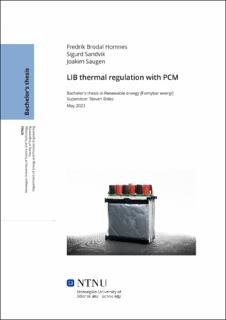| dc.contributor.advisor | Boles, Steven | |
| dc.contributor.author | Homnes, Fredrik Brodal | |
| dc.contributor.author | Sandvik, Sigurd | |
| dc.contributor.author | Saugen, Joakim | |
| dc.date.accessioned | 2023-07-06T17:21:40Z | |
| dc.date.available | 2023-07-06T17:21:40Z | |
| dc.date.issued | 2023 | |
| dc.identifier | no.ntnu:inspera:142213037:147032175 | |
| dc.identifier.uri | https://hdl.handle.net/11250/3076947 | |
| dc.description.abstract | Litium-ionbatterier (LIB) øker i etterspørsel og etter hvert som de blir tilpasset flere
bruksområder må også kjøleteknologien tilpasses. Revolve NTNU er en studentorganisasjon
som designer og konstruerer elektriske racerbiler for banekonkurranser. De bygger ny bil hvert
år og de leter alltid etter måter å forbedre bilen. Denne bacheloroppgaven utforsker hvordan
faseendringsmaterialer (PCM) kan brukes til termisk regulering av LIB-er. Hovedmålene i dette
bachelorprosjektet var å undersøke muligheten for å erstatte tradisjonelle metoder som f.eks luft-
og vannkjøling med PCM-kjøling og for å teste PCMs brannforebyggende egenskaper.
I løpet av semesteret ble det gjennomført fire hovedtester/eksperimenter. Den første testen var
en varmekapasitetstest av både celle og PCM for å fastslå at produsentens data samsvarte med
egne funn. Med fakta om varmekapasitet i PCM og LIB kan dimensjonering for mengden varme
som må fjernes for trygg og effektiv drift beregnes.
Den andre testen var lasttesting fra en faktisk løpsbelastning. Denne testen ble utført for å
samle inn data om kjøleevnen til PCM og lyktes i å etablere et klart mønster av tilfredsstillende
kjøleytelse.
Den tredje testen som ble utført var en intern motstandstest. Hovedmålet med denne testen var
å fastslå ved hvilken temperatur cellene har optimal virkningsgrad. Når man kjenner til optimal
virkningsgrad og driftstemperatur gjør det mulig å balansere effektivitet med aldring for å oppnå
lengre levetid for batteriet.
Den fjerde testen var en termisk nedsmelting hvor hovedmålene var å etablere brann-forebyggende
egenskaper til den valgte PCM og samle data som viser når omtrentlig ved hvilken temperatur
termisk nedsmelting starter. Kun én av tenningsmetodene klarte å utløse termisk nedsmelting,
og PCM-en klarte ikke å stoppe brannen. Testene viste at PCM-en var i stand til å redusere
tiden det tok for de andre cellene tok fyr, men at en mer kompakt utforming av cellespakken var
nødvendig.
Som konklusjon kan dataene samlet i denne bacheloroppgaven brukes pålitelig til å gjennomføre
dimensjonering av PCM for kjøling av Melastas litium-ion-celler. Fordelene med å bruke PCM
kjøling sammenlignet med luftkjølingssystemet i den eksisterende Revolve bilen er betydelige og
kan øke bilens ytelse. | |
| dc.description.abstract | Lithium ion batteries (LIB) are in increasing demand and as they get adapted for more
applications, and so must the cooling technology adapt. Revolve NTNU is a student organisation
that designs and constructs electric race cars for track competitions. This is a yearly build and
they are always looking for ways to improve the cars performance. This bachelors thesis explores
how phase change materials (PCM) can be used for thermal regulation of LIBs. The main goals
of this bachelors project were to investigate the feasibility of replacing traditional methods such
as air- and water cooling with PCM cooling and to test the fire prevention capabilities of PCM.
During the course of the semester, four main tests and experiments were conducted. The first
test was a heat capacity test of both cell and PCM to establish that the manufacturer data
matched our own findings. Subsequently, dimensioning for the amount of heat that needed to
be removed for safe and efficient operating conditions could be calculated.
The second test was load testing from an actual race load. This test was conducted to collect
data on the cooling capabilities of the PCM and was successful in establishing a clear pattern of
satisfactory cooling performance.
The third test conducted was an internal resistance test. The main goal of this test was to
establish at which temperature the cell efficiency was optimal. Knowing the peak efficiency
operating temperature allows for balancing efficiency with ageing to achieve longer cycle life.
It was found that the optimal operating temperature for the cells was 35◦C and above, which
matches the PTT of the PCM.
The fourth test was a thermal runaway test where the main goals were to establish the fire
prevention capabilities of the chosen PCM and get an approximate temperature at which thermal
runaway starts. Only one of the ignition methods manged to trigger thermal runaway and PCM
was unable to stop the fire. The tests showed that the PCM was able to reduce the time it took
for the other cells to catch fire, but that a more compact design of the cell stack was needed.
In conclusion, the data gathered in this bachelors thesis could be reliably used to conduct
dimensioning of PCM for cooling the Melasta lithium ion cells. The benefits of using PCM
cooling compared to the air cooling system in the existing Revolve race car are substantial and
could increase the performance of the car. | |
| dc.language | eng | |
| dc.publisher | NTNU | |
| dc.title | LIB thermal regulation with PCM | |
| dc.type | Bachelor thesis | |
